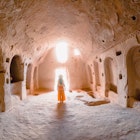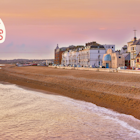Agreeably walkable downtowns and plentiful sea-view cafes make the small eastern Black Sea cities of Giresun and Ordu – each with a population fewer than 250,000 people – pleasant stops on a coastal road trip in Türkiye.
Though settlements were founded in this area as Greek colonies as far back as the 7th century BCE, little visible remains of that ancient history, with the smattering of historic buildings in both cities mostly dating to the last two centuries. The real reason to come is as a jumping-off point to explore the Black Sea region’s distinctive blue-meets-green geography: blue for the waves that crash on its rocky shores and green for the lush hillsides that rise steeply from the coast. This forested interior is dotted with remote mountain villages and yaylalar (mountain pastures), along with canyons, waterfalls and other natural beauties to discover.

When should I go to Giresun and Ordu?
Summer is the busiest season, as travelers, largely from elsewhere in Türkiye and countries in the Middle East, seek respite from the heat at home on the Black Sea’s beaches. It can still be pretty warm though – typically mid-20°Cs but sometimes hitting low- to mid-30°Cs (around 77–95°F) – and humid in July and August, so head for the region’s cooler yaylalar and mountain areas. It’s also the time for local village festivals marking the beginning of the hazelnut harvest, which typically starts in August.
Spring and autumn are pleasant for exploring though access to the yaylalar may be limited by snow. Winter travel is best avoided; the weather is typically rainy and cold – dipping into the low single digits along the coast and below-0°C (32°F) temperatures in the highlands – and some mountain areas get snowed in.
How much time should I spend in Giresun and Ordu?
Two or three days is enough to see the sights in both city centers, which are 50km (31 miles) apart. You’ll need at least four or five days to include some time in the mountains as minibus services are limited and travel between villages typically either involves backtracking down to the coast or driving on narrow, winding roads that aren't always fully paved.
Is it easy to get to and around Giresun and Ordu?
Ordu–Giresun Airport sits roughly halfway between the two cities and is served by daily flights from both of Ìstanbul’s airports. The Havaş airport shuttle bus (timed to the flight schedules) takes 30 to 45 minutes to reach either city. (In Ordu, the “eski otogar” stop is closest to the city center; for Giresun, ask for the “liman,” or port.) Getting between Giresun and Ordu by minibus takes around 1 to 1 ½ hours.
Both Ordu and Giresun have walkable city centers, with regular minibus connections to smaller towns along the coast. Exploring the yaylalar, mountain waterfalls and other inland natural beauties is much easier with your own car, however, as many villages are served by only a single daily minibus or none at all.

Top things to do in Giresun and Ordu
Clamber around castles
The remains of the 2nd-century BCE hilltop castle overlooking Giresun’s old town make for one of the city’s most pleasant spots, with tree-shaded paths and picnic areas aplenty and fine views from the old fortifications of the city, the coastline and the sea. Some 45km (28 miles) east along the coast, the Tirebolu Castle perches picturesquely on a small peninsula jutting out from the harbor; just below, the simple fish restaurant Balıkçı Yusufun Yeri serves up the catch of the day in a casual setting.
See Ordu from above
Ordu’s top city-center attraction is its 2372m-long (7782-ft) cable car (teleferik), which glides from the coast to the top of Boztepe, a small peak 500m (1640ft) above sea level, in around 10 minutes. Terrace cafes, restaurants and snack and souvenir stands sit lined up next to the cable car’s hilltop terminus. The main draw is the views, which are especially popular at sunset.

Breathe the fresh mountain pasture air
Traditionally, local herders would migrate with their livestock each summer to the yaylalar (mountain pastures) where the animals could feast on tender grasses and wildflowers – all the better to make the tastiest butter, yogurt, milk and cheese. Some continue these practices today, but more families return to their yayla homes as an annual respite from urban life. There are dozens, if not hundreds of yaylalar in the mountains above both cities; Perşembe Yaylası and the yaylalar around Mesudiye village in Ordu province and Kulakkaya Yaylası in Giresun province are among the most popular for day visits or overnight stays in mountain lodges and cabins.
Feast on regional food
It may not be as well-known as kebabs and meze, but Turkish Black Sea cuisine is distinctive and delicious – hearty fare with a flair for seasonal herbs and greens, pickled vegetables and of course freshly caught fish. Tuck into lightly battered and fried anchovies (hamsi) in season or a tomatoey, peppery scorpion fish (iskorpit) stew at Derin Balık, a casual, good-value seafood restaurant in Ordu. Or visit the tiny Yöresel Lezzetler Durağı on Fevzi Paşa Caddesi in Giresun for home-cooked dishes like ısırgan yağlası, a soup-like nettle puree, or pancar sarması, beet greens stuffed with rice, spices and (sometimes) mincemeat. Giresun is also famed for its hazelnuts; try a findik ezmeli sütlü kadayıf, a hazelnut-paste dessert topped with (you guessed it) crushed hazelnuts, at the sweetshop Mustafa Patar Tel Kadayıf.
Meander through museums
The small museums in Ordu and Giresun are more notable for their architecture than their collections; the Giresun Museum (home to perhaps the world’s only minaret-shaped wooden stove) and the Taşbaşı Art Gallery in Ordu are both inside 19th-century churches that were left abandoned when Turkey’s Greek Orthodox communities were compulsorily relocated to Greece in the post-WWI population exchange of 1923. Ordu’s Paşaoğlu Mansion & Ethnography Museum is set in an attractive 19th-century mansion, as is the surprisingly interesting Kahraman Sağra Hazelnut Museum – with full English-language wall texts and labels – across the street.

My favorite thing to do in Giresun and Ordu
I loved strolling out onto the windswept cape called Yason Burnu, which juts into the Black Sea just 30km (18 miles) northwest of Ordu city center. The stone church along the walking path dates to the mid-1800s but the cape gets its name from the much older story of Jason and the Argonauts, heroes of Greek mythology who are said to have moored here while on their quest to find the Golden Fleece. It’s definitely the kind of landscape to inspire an epic tale or two.
How much money do I need for Giresun and Ordu?
Despite the ongoing inflation crisis in Türkiye, travel costs in this part of the country are still very reasonable, especially compared to tourist hot spots like Ìstanbul, Bodrum and Cappadocia. Hotel costs outside the summer high season can be half of what’s listed below.
- Simple hotel room for two: ₺2000–3000 ($60–90)
- Local one-way minibus fare: ₺14–20 ($0.40–0.60)
- Short-distance taxi ride: ₺150 TL ($4.50)
- Cup of çay (tea) and a local sweet: ₺80–100 ($2.50–3)
- Two-scoop ice-cream cone: ₺40 ($1.25)
- Round-trip cable car ride in Ordu: ₺200 ($6)
- Simple lunch for two: ₺400-600 ($12–18)
- Fish dinner for two (no alcohol): ₺1000–1500 ($30–45)
- Car rental per day: ₺1500–2000 ($45–60)












